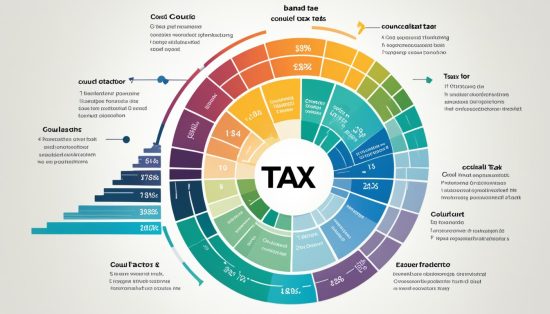Last Updated on: 3rd July 2024, 06:53 am
Welcome to our complete guide on Council Tax Band F! If you’re a homeowner or a renter in the United Kingdom, you’re likely familiar with the concept of council tax. This local taxation is levied by local authorities to fund public services such as schools, roads, and waste collection. The amount you pay in council tax is determined by the valuation of your property, which is classified into different bands. In this article, we will delve into Council Tax Band F – what it means, how it is calculated, and what you can expect if your property falls into this particular band. So, let’s get started and unravel the mysteries of Council Tax Band F!
What is Council Tax Band F?
In the framework of the UK’s Council Tax system, council tax band F is explained as a classification that encompasses various properties based on their valuation on certain assessment dates. Specifically, for properties in England, council tax band F includes those valued between £120,001 and £160,000 as of 1 April 1991. In Wales, the range is slightly higher, capturing properties valued between £162,001 and £223,000 as of 1 April 2003.
The allocation of a property to council tax band F significantly impacts the taxation amount paid by homeowners. This band, being on the higher side of the tax spectrum, suggests a substantial property valuation, thereby attracting a higher tax liability. Council tax band f review processes help ensure that properties are assessed fairly, reflecting any changes in the housing market or property modifications that might affect value.
Due to inevitable shifts in the market and alterations to housing stock, there are instances where council tax band f increase discussions become pertinent. These discussions are typically triggered by extensive property renovations that substantially increase a home’s market value, thereby moving it into a higher tax band. Conversely, if property values fall or if the banding is deemed incorrect, homeowners can challenge their assigned band through a formal review process.

| Year | Council Tax Charge (£) | Water Supply (£) | Waste Water Charge (£) | Total (£) |
|---|---|---|---|---|
| 2018-19 | 2059.36 | 292.37 | 339.43 | 2691.16 |
| 2019-20 | 2238.11 | 306.93 | 356.33 | 2901.37 |
| 2020-21 | 2285.24 | 300.14 | 350.00 | 2885.38 |
This detailed assessment of council tax band F underscores its depth within the taxation system, affecting both individual homeowners and the broader fiscal policy directions. Understanding and reviewing one’s council tax band is crucial, especially with periodic regulations and tax adjustments that could affect homeowners’ financial obligations.
The Valuation Basis for Council Tax Band F
Understanding the valuation foundation for council tax band F is essential to ensure that homeowners are correctly taxed according in line with historical market data. This section dives into the pivotal dates, ranges, and the instrumental role the Valuation Office Agency (VOA) plays within England and Wales.
1. Understanding Valuation Dates
For council tax band F property values, the valuation particularity is distinct between England and Wales due to the different base valuation dates used for tax calculations. These dates are crucial as they determine the property value which drives the council tax band a property is placed in. In England, the properties are assessed based on their market values as of 1 April 1991, while Wales uses the valuation date of 1 April 2003. This datum is vital for anyone looking to understand or contest their property’s banding.
2. Property Band Ranges in England and Wales
The division of council tax bands in England spans from band A to H, with band F encompassing properties valued between £159,001 and £212,000 as of 1991. Similarly, in Wales, following the 2003 revaluation, properties falling within band F range from £158,001 to £223,000. For homeowners considering how to appeal council tax band F, familiarising oneself with these ranges is the first step.
3. Role of the Valuation Office Agency (VOA)
The VOA plays a pivotal role in the assessment, maintenance, and revision of council tax bands. Not only does it handle the initial classification of newly constructed homes into appropria
te council tax bands, but it also reviews existing bands upon request. For individuals assessing how to appeal council fire chronicles tax band F, understanding the function of the VOA, including its processes for contesting a band reassessment, is essential.

Whether you are moving into a new property, or you suspect a discrepancy in your council tax banding, engaging with the VOA can provide clarity or necessary adjustments. This becomes particularly relevant when significant changes to a property, such as extensions or alterations, may influence its market value and by extension, its council tax band. Knowing the parameters for how to appeal council tax band F can potentially lead to considerable savings, especially if the property has been placed in an incorrect band.
Thus, staying informed about your property’s valuation date, understanding the property value ranges for your respective band, and the role of the VOA are fundamental in ensuring you pay the correct amount towards council tax and understand fully when and how to lodge an appeal or review your band assessment.
How Council Tax Band F is Assessed?
Understanding the assessment process for a property’s placement within Council Tax Band F is vital for homeowners aiming for a fair taxation rate. The assessment, conducted by the Valuation Office Agency (VOA), involves a detailed analysis of several pivotal factors. Size, layout, character, and precise location of the property are scrutinised closely. As properties are valued based on their market state as of 1 April 1991 in England, or 1 April 2003 in Wales, any significant structural alterations or changes in the use of the property could influence its assessment.

For homeowners concerned with the potential inaccuracies in their council tax assessments or those considering renovations that might alter their property’s value, understanding the grounds for valuation adjustments is critical. If you think your property may be misvalued, utilising a council tax band f calculator can provide an initial idea of whether you might be due a reduction. Moreover, considering property improvements or changes, understanding the impact on your council tax band can be managed through direct consultations with the VOA.
It’s essential for taxpayers to continue settling their council tax bills during any appeal or reassessment process to avoid penalties. Should the challenge result in a band adjustment, the council tax band f reduction would be effectively reflected, and any excess payment previously made would be refunded.
Here is an illustration of how various factors can potentially lead to a reassessment into a different council tax band:
- Significant property extensions or reductions.
- Change in the property’s use (e.g., residential to commercial).
- Development affecting the local area impacting property values.
This rigorous assessment ensures that every homeowner contributes a fair amount relative to the value and specifics of their property. For those keen on managing their council tax effectively, understanding these assessment criteria is paramount.
The Process of Allocating Council Tax Bands to New Properties
When it comes to understanding how new builds are integrated into the existing council tax system, a clear assessment process is crucial. Here, both the responsibilities of new homeowners and the criteria used to assign a council putative tax band become pertinent, particularly for those falling within council tax band F.
1. Responsibilities When Moving into a New Build
New residents must proactively engage with their local council upon moving into a new build that hasn’t been previously banded. This notification initiates the process whereby the local council contacts the Valuation Office Agency (VOA) to assess and determine the appropriate council tax band. It’s essential for residents to provide complete and accurate information about their property to facilitate a swift and fair council tax band f review.
2. Assessment Criteria for Newly Built Properties
The VOA uses specific criteria to gauge the appropriate council tax band for new constructions. These include the size and layout of the property, its character, prime location, and the comparative market values as of the statutory valuation dates. Such thorough evaluation ensures that the council tax band f explained reflects the property’s fair value.
For council tax band F, properties typically range from £120,001 to £160,000, categorizing them based on a combination of factors such as architectural style and regional market trends, which may be influenced by local amenities and infrastructure developments.
| Aspect | Criteria |
|---|---|
| Property Size | Overall square footage and number of rooms |
| Property Value | Market value as of the last valuation date |
| Location | Local amenities, transportation links, and neighbourhood desirability |
| Property Character | Architectural type, historical significance, and construction quality |
Adherence to these assessment guidelines ensures that all newly constructed properties are taxed fairly, creating a balanced and effective fiscal allocation that supports municipal and community services.0
Checking and Changing Your Council Tax Band
If you suspect that your property might be inaccurately assessed under council tax band F, understanding how to appeal council tax band F is crucial. Whether you’re facing a council tax band F increase or seeking a council tax band F reduction, the steps to verify or alter your tax band are straightforward but require attention to detail.
Initially, examination of your current council tax band through your local council’s website or directly via the Valuation Office Agency (VOA) is necessary. Significant changes to your property or its surroundings might warrant a reevaluation of your council tax band. Here’s how you can initiate an examination or revaluation request:
- Collect evidence indicating why your property’s valuation might be incorrect. This includes sale prices of similar properties in your area or substantial changes to your property that are not reflected in the current banding.
- Contact the VOA to discuss your findings and present your case for reevaluation.
- Formally submit an appeal if there is disagreement with the VOA assessment.
Keep in mind that revaluations can lead to either an increase or a reduction in your council tax band. Therefore, ensure your appeal is backed by robust evidence.
Council Tax Band F and Houses in Multiple Occupation (HMOs)
Understanding the implications of council tax band f property values and potential council tax band f increases on HMOs is crucial for property owners. As of December 2023, significant changes are set to redefine how these properties are evaluated for council tax purposes in England, while different rules apply in Wales.
1. Banding Changes in England from December 2023
In England, the change in council tax assessment due to the classification of HMOs as single units brings about a unified approach, potentially increasing the council tax liability significantly for landlords. These units will no longer be assessed on a room-by-room basis, leading to a singular council tax bill that could reflect a council tax band f increase, influencing both property values and rental strategies.
2. Wales: Banding of HMOs and the VOA’s Approach
Wales retains a more segmented approach depending on the property’s adaptations. For example, minor modifications might not alter the band classification significantly; however, extensive renovations creating self-contained units may necessitate individual council tax assessments. This can affect the overall financial evaluation of the property within council tax band F, underlining the importance of careful planning during renovations or property conversions.
Examples of HMO Banding Scenarios
Consider two theoretical examples to illustrate these points. Firstly, an HMO in England, following the newest regulations, where despite having multiple tenants, the entire property is banded collectively, potentially in council tax band F. Conversely, in a Welsh HMO adapted into several self-contained flats, each unit could be assessed separately, possibly falling into different council tax bands based on width and amenities, echoing differences in council tax band f property values.
It’s vital for HMO landlords and potential investors to understand these legislative distinctions and prepare accordingly. Landlords need to consult with local councils and possibly seek revaluation if they believe their property’s current banding might be incorrect due to these new rules. Furthermore, being equipped with evidence of property values and understanding the rights for appealing council tax bands is crucial in ensuring fair taxation.
These changes highlight a potentially pivotal council tax band f increase for many properties considered luxurious with notable amenities, thereby affecting investment returns and decisions in the HMO market.

The table below outlines the comparative rates and potential financial outcomes for typical HMO setups in Tooting and Nottingham under the new regulations:
| Location | Council Tax Band (Pre-2023) | Council Tax Band (Post-2023) | Annual Council Tax Cost |
|---|---|---|---|
| Tooting | Band E | Band F | £2,500 |
| Nottingham | Band D | Band F | £2,200 |
This comparative overview emphasises the council tax band f increase and how it impacts the financial landscape for HMO landlords, urging them to assess and possibly reconsider the layout and utilisation of their properties to optimise tax efficiency and property value.
Council Tax Band F for Annexes and Home Modifications
Understanding how annexes and home modifications impact the council tax band is essential for homeowners wishing to ensure they are assessed fairly and possibly benefit from a council tax band f reduction. As housing needs evolve, many homeowners opt to create self-contained units within their primary residence, often for aging relatives or as rental spaces. These additions, known as annexes, can modify the property’s council tax valuation and potentially call for a council tax band f review.
1. Banding for Self-Contained Annexes
Annexes offer a unique question in council tax band assessment. Typically used as separate dwellings, they are evaluated based on whether they are self-contained, meaning they have their own facilities like kitchens and bathrooms. Council Tax regulations stipulate that these structures can sometimes attract a separate banding if they meet the criteria of being self-standing living accommodations. Moreover, properties classified as annexes and similar types receive up to a 50% discount on their council tax if occupied by dependents of the main property owner. This can serve as a crucial council tax band f reduction strategy.
2. Impact of Structural Changes on Banding
Significant structural modifications to an existing property can necessitate a reevaluation of its council tax band. Activities such as building extensions, removal of interior walls, or major refurbishments could result in the property falling into a different band once the Valuation Office Agency (VOA) conducts a reassessment. However, it’s important to understand that some smaller modifications, such as adding or removing non-structural fixtures, generally do not affect the council tax banding unless they significantly change the dwelling’s utility or layout. The VOA considers permanent changes that impact the living space’s footprint or usability in determining if a reassessment is necessary, potentially leading to council tax band f reviews or adjustments.
Homeowners anticipating or undergoing significant transformations to their properties should consider how these changes might affect their council tax band, particularly if aiming for a council tax band f reduction. Prompt discussions with the local council and understanding the implications of such modifications can help in effectively managing and potentially lowering council tax obligations.
Conclusion
Understanding the intricacies of Council Tax Band F and the wider tax band system is critical for UK residents who wish to manage their finances effectively. The council tax band f explained in our article illustrates how property values, as of 1 April 1991, play a pivotal role in determining how much homeowners are required to contribute to local services annually. With council tax rates being subject to periodic reassessment, knowing how to appeal council tax band f can be an invaluable asset for those who believe their property has been misclassified.
Our study has underscored the potential variance in council tax across the different regions of the UK. In Tower Hamlets, for example, we see a considerable spread from £1,117.01 for Band A to £3,351.02 for Band H in the 2024/25 tax year, reflecting a diverse range of property values. Moreover, certain changes to your circumstances or property, such as its adaptation for disabilities, can qualify you for deductions or exemptions. Keeping abreast of these conditions, and understanding the assessment criteria for new builds, as well as the complexities surrounding HMOs and annexes, could lead to significant savings.
For residents grappling with whether they might be due a reduction or challenging their current tax band, we’ve laid out clear guidance on available avenues and the associated processes. If you think your council tax band does not reflect the true value of your home, or if changes have occurred since the last valuation, the option to appeal is there – and with informed action, it is a step that could potentially yield favourable results. Making informed decisions rooted in the latest regulatory frameworks ensures that individuals are well-equipped to engage with local authorities on Council Tax matters effectively.
FAQ
1. What factors determine Council Tax Band F?
Council Tax Band F is determined based on a property’s market value on the valuation date which is 1 April 1991 for England and 1 April 2003 for Wales. Properties are assessed by the Valuation Office Agency (VOA) and placed into band F if their value falls within the set ranges for each respective country at those dates.
2. Can I use a council tax band F calculator to determine my payments?
Yes, you can use a council tax band F calculator to get an estimated amount of your council tax payments. However, for an accurate figure, you should refer to your local council as rates can vary depending on the local authority’s charges.
3. How can I review or appeal my Council Tax band?
If you believe your Council Tax band is incorrect, you can contact the Valuation Office Agency (VOA) to review your band. If after the review you still feel the decision is wrong, you can formally challenge the banding by making an appeal to the VOA and providing evidence to support your case.
4. Will improvements to my property affect my Council Tax Band F?
Improvements that increase the value of your property, such as extensions or significant renovations, could result in your property being reassessed and potentially moved to a higher council tax band upon the next relevant sale or other triggering event.
5. What should I do if I move into a property that does not have a Council Tax band?
If you move into a new build or a property that has not been banded, you should notify your local council. They will inform the VOA, which will then assess the property and allocate an appropriate council tax band based on various factors, including its size, layout, and market value as of the valuation date.




















No Comments
Leave a comment Cancel